Related Research Articles

Albay, officially the Province of Albay, is a province in the Bicol Region of the Philippines, mostly on the southeastern part of the island of Luzon. Its capital is the city of Legazpi, the regional center of the whole Bicol Region, which is located in the southern foothill of Mayon Volcano.

Sorsogon, officially the Province of Sorsogon, is a province in the Philippines located in the Bicol Region. It is the southernmost province in Luzon and is subdivided into fourteen municipalities (towns) and one city. Its capital is Sorsogon City and borders the province of Albay to the north.
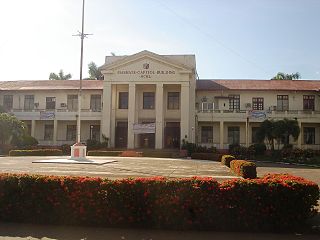
Masbate, officially the Province of Masbate, is an island province in the Philippines located near the midsection of the nation's archipelago. Its provincial capital is Masbate City. The province consists of three major islands: Masbate, Ticao and Burias.
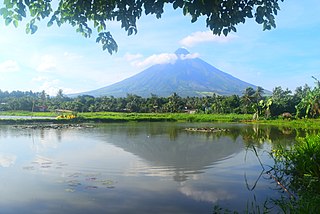
Bicol, known formally as the Bicol Region or colloquially as Bicolandia, is an administrative region of the Philippines, designated as Region V. Bicol comprises six provinces, four on the Bicol Peninsula mainland – Albay, Camarines Norte, Camarines Sur, and Sorsogon – and the offshore island provinces of Catanduanes and Masbate.
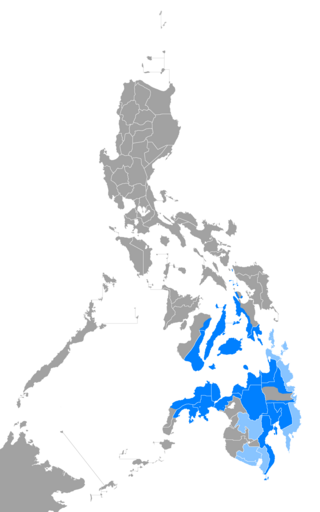
Cebuano is an Austronesian language spoken in the southern Philippines. It is natively called by its generic term Bisaya or Binisaya and sometimes referred to in English sources as Cebuan. It is spoken by the Visayan ethnolinguistic groups native to the islands of Cebu, Bohol, Siquijor, the eastern half of Negros, the western half of Leyte, and the northern coastal areas of Northern Mindanao and the Zamboanga Peninsula. In modern times, it has also spread to the Davao Region, Cotabato, Camiguin, parts of the Dinagat Islands, and the lowland regions of Caraga, often displacing native languages in those areas.
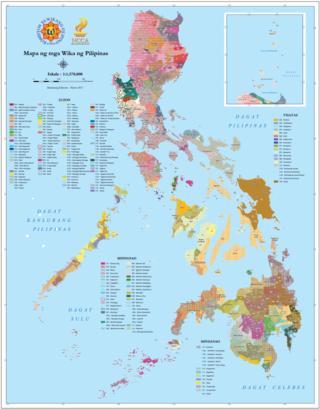
There are some 120 to 187 languages spoken in the Philippines, depending on the method of classification. Almost all are Malayo-Polynesian languages native to the archipelago. A number of Spanish-influenced creole varieties generally called Chavacano along with some local varieties of Chinese are also spoken in certain communities. The 1987 constitution designates Filipino, a standardized version of Tagalog, as the national language and an official language along with English. Filipino is regulated by Komisyon sa Wikang Filipino and serves as a lingua franca used by Filipinos of various ethnolinguistic backgrounds.

The Bisayan languages or Visayan languages are a subgroup of the Austronesian languages spoken in the Philippines. They are most closely related to Tagalog and the Bikol languages, all of which are part of the Central Philippine languages. Most Bisayan languages are spoken in the whole Visayas section of the country, but they are also spoken in the southern part of the Bicol Region, islands south of Luzon, such as those that make up Romblon, most of the areas of Mindanao and the province of Sulu located southwest of Mindanao. Some residents of Metro Manila also speak one of the Bisayan languages.

Tausug is an Austronesian language spoken in the province of Sulu in the Philippines and in the eastern area of the state of Sabah, Malaysia, by the Tausūg people. It is widely spoken in the Sulu Archipelago, the Zamboanga Peninsula, southern Palawan, and Malaysia.
The Central Philippine languages are the most geographically widespread demonstrated group of languages in the Philippines, being spoken in southern Luzon, Visayas, Mindanao, and Sulu. They are also the most populous, including Tagalog, Bikol, and the major Visayan languages Cebuano, Hiligaynon, Waray, Kinaray-a, and Tausug, with some forty languages all together.

Surigaonon is an Austronesian language spoken by Surigaonon people. As a regional Philippine language, it is spoken in the province of Surigao del Norte, Dinagat Islands, Surigao del Sur, and some portions of Agusan del Norte, especially the towns near the Mainit Lake, Agusan del Sur and Davao Oriental.

Masbateño or Minasbate is a member of Central Philippine languages and of the Bisayan subgroup of the Austronesian language family spoken by more than 724,000 people in the province of Masbate and some parts of Sorsogon in the Philippines. Masbatenyo is the name used by the speakers of the language and for themselves, although the term Minásbate is sometimes also used to distinguish the language from the people. It has 350,000 speakers as of 2002, with 50,000 who speak it as their first language. About 250,000 speakers use it as their second language.
Ratagnon is a regional language spoken by the Ratagnon people, an indigenous group from Occidental Mindoro. It is a part of the Bisayan language family and is closely related to other Philippine languages. Its speakers are shifting to Tagalog. In 2000, there were only two to five speakers of the language. However, in 2010 Ethnologue had reported there were 310 new speakers.

Central Bikol, commonly called Bikol Naga or simply as Bikol, is an Austronesian language spoken by the Bicolanos, primarily in the Bicol Region of southern Luzon, Philippines. It is spoken in the northern and western part of Camarines Sur, second congressional district of Camarines Norte, eastern part of Albay, northeastern part of Sorsogon, San Pascual town in Masbate, and southwestern part of Catanduanes. Central Bikol speakers can be found in all provinces of Bicol and it is a majority language in Camarines Sur. The standard sprachraum form is based on the Canaman dialect.
The Greater Central Philippine languages are a proposed subgroup of the Austronesian language family, defined by the change of Proto-Malayo-Polynesian *R to *g. They are spoken in the central and southern parts of the Philippines, and in northern Sulawesi, Indonesia. This subgroup was first proposed by Robert Blust (1991) based on lexical and phonological evidence, and is accepted by most specialists in the field.
The Proto-Philippine language is a reconstructed ancestral proto-language of the Philippine languages, a proposed subgroup of the Austronesian languages which includes all languages within the Philippines as well as those within the northern portions of Sulawesi in Indonesia. Proto-Philippine is not directly attested to in any written work, but linguistic reconstruction by the comparative method has found regular similarities among languages that cannot be explained by coincidence or word-borrowing.

The Bikol languages or Bicolano languages are a group of Central Philippine languages spoken mostly in the Bicol Peninsula in the island of Luzon, the neighboring island province of Catanduanes and the island of Burias in Masbate.
The Bantayanon language is the regional language of the Bantayan islands in the Philippines. It is a part of the Bisayan language family and is closely related to Waray and Hiligaynon. There are three dialects of Bantayanon, based in the three municipalities that comprise the island group: Binantayanun, Linawisanun, and Sinantapihanun, the most idiosyncratic of the three. There are also significant dialectal differences between the speech patterns of those that live in the town centers and those that live outside of the more rural areas of the islands.
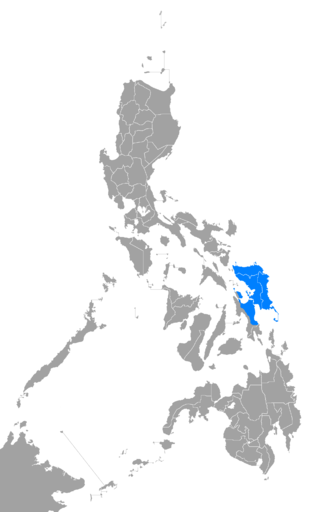
Waray is an Austronesian language and the fifth-most-spoken native regional language of the Philippines, native to Eastern Visayas. It is the native language of the Waray people and second language of the Abaknon people of Capul, Northern Samar, and some Cebuano-speaking peoples of western and southern parts of Leyte island. It is the third most spoken language among the Bisayan languages, only behind Cebuano and Hiligaynon.
Southern Sorsogon is an Austronesian language spoken in the southern part of Sorsogon, Philippines, in the municipalities of Gubat, Barcelona, Bulusan, Santa Magdalena, Matnog, Bulan, and Irosin. Although located in the Bicol Region, Southern Sorsogon belongs to the Warayan Bisayan subgroup, and is mutually intelligible to Waray which is spoken to the south on the neighboring island of Samar. The other two Bisayan languages spoken in the Bicol Region are Masbate Sorsogon and Masbateño.
Northern Sorsogon is a Bisayan language spoken in the central part of Sorsogon, Philippines, in Sorsogon City and the municipalities of Casiguran, and Juban. It is closely related to, but distinct from Southern Sorsogon which is spoken in the southern part of Sorsogon.
References
- 1 2 3 Zorc, David Paul (1977). The Bisayan Dialects of the Philippines: Subgrouping and Reconstruction . Canberra, Australia: Dept. of Linguistics, Research School of Pacific Studies, Australian National University. doi: 10.15144/PL-C44 . ISBN 0858831570.
- ↑ Ethnologue map of Southern Philippines
- ↑ McFarland, Curtis D. The dialects of the Bikol area. OCLC 7764811.